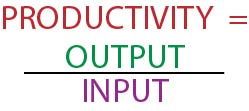Full Sail Partners Blog
Measuring Employee Productivity and Profitability with Software
 Of all the metrics that professional services firms can track, two of the most important are utilization and realization. These are different, but related ways of measuring employee productivity and profitability. Both can be measured with a high degree of accuracy — and made visible to management — using software.
Of all the metrics that professional services firms can track, two of the most important are utilization and realization. These are different, but related ways of measuring employee productivity and profitability. Both can be measured with a high degree of accuracy — and made visible to management — using software.
A quick jargon review
Utilization measures the hours charged to a client’s project compared to the total available hours (usually 40 hours per week). For example, if an employees’ expected work week is 40 hours and the employee achieves 35 hours of client chargeable work then their utilization rate is 87.5%.
Utilization is not necessarily within an employee’s control: for example, an employee might be working on an important internal project that can’t be billed. Because of the many variables that affect utilization, the longer the period over which it’s tracked — say, over the course of a year — the more useful it is in evaluating performance against employee and company goals.
The second metric, realization, refers to the actual revenue based on employees’ hours charged and billed to clients compared to what they should have generated from their utilization achieved. It’s a measure of their profitability, and a metric that provides valuable insight into how well a company is able to translate hours worked on projects into revenue. In a perfect world utilization and realization will be equal, but this is rarely the case. Realization can also help in compensation and promotion reviews, staffing decisions, project and unit pricing and assessing the health of the company itself.
The impact of measuring employee productivity and profitability can be enhanced further by a commitment to Earned Value Management (EVM), a project management technique for objectively measuring project performance and progress. Together, these techniques help a firm gain a clear, objective view of employee and project performance, identify where resources are over- and under-utilized, and optimize workforce utilization and profitability.
Software solutions
There are a number of software solutions for measuring employee productivity and profitability. Some focus specifically on project and resource management, while others provide these functions as part of larger, more integrated solutions.
For example, Deltek Vision can provide a firm with comprehensive visibility into its organization, efficient oversight of its projects and people, and efficient automation of processes. Most significantly, it allows the firm to be proactive rather than reactive in addressing resource management issues, thus increasing the probability of project success. On a more tactical level, the product’s Employee Realization feature allows a user to track and report on realization values, compare utilization vs. realization, optimize staff utilization, minimize scheduling conflict, and substantially reduce the potential for missed milestones.
Whatever approach an organization uses in measuring employee productivity and profitability, doing so requires a sustained effort and commitment on the part of management. Handled correctly, however, the payoff is immense: instant visibility into resource commitments across an entire organization, and granular awareness of who is available (and when) with the skills needed to satisfy projects’ technical requirements.
Subscribe Here!
Latest Posts
Posts By Category
- Professional Services (232)
- Technology Solutions (156)
- Deltek Vantagepoint (131)
- Deltek Vision (120)
- Building Business (114)
- Accounting (103)
- Project Management (102)
- CRM (76)
- Press Release (61)
- ERP (54)
- HR (53)
- Marketing (53)
- Client Relationships (48)
- Professional Services Firms (42)
- Deltek Clarity Report (27)
- Project Based Firms (26)
- Finance (24)
- Business Intelligence (21)
- A&E Firms (20)
- Support (20)
- Cloud (18)
- Employees (18)
- Deltek Talent (16)
- Video (16)
- Mobile (15)
- Communication (9)
- Deltek Insight (9)
- Mergers and Acquisitions (9)
- Data Visualization (8)
- Project Information Management (PIM) (8)
- Case Study (6)
- Executives (6)
- Information Technology (5)
- Driving Growth (4)
- Human Capital Management (4)
- business development (4)
- Artificial intelligence (AI) (3)
- Resource Management (3)
- THOUGHT LEADERSHIP (3)
- human resources (3)
- Connect Add-In (2)
- Contract Management (2)
- Deltek ProjectCon (2)
- Outsourced HR (2)
- Project Con (2)
- ProjectCon (2)
- Proposal (2)
- Change Management (1)
- Deltek + ComputerEase (1)
- Deltek Dela (1)
- Outsourced Accounting (1)
- SEO (1)
- password security (1)
Posts by Author
- Amanda McClain (3)
- Amanda Roussel (19)
- Amy Balassone (10)
- Aria Bounds (1)
- Bryce Crosby (1)
- Cate Phillips (9)
- Chris Simei (2)
- Cynthia Fuoco (3)
- Dale Busbey (5)
- Erin Haver (1)
- Evan Creech-Pritchett (24)
- Full Sail Partners (104)
- Gina Stamper (3)
- Heath Harris (4)
- Jake Lucas (3)
- Jeff Robers (1)
- Jennifer Renfroe (65)
- Jennifer Stevland (1)
- Jennifer Wilson (2)
- Jenny Labranche (4)
- Joel Slater (9)
- Kelly Duquette (2)
- Kevin Hebblethwaite (8)
- Kim Stamps (2)
- Lee Frederiksen (1)
- Lindsay Diven (41)
- Lisa Ahearn (6)
- Matt McCauley (4)
- Michael Kessler, PMP (17)
- Nia Collins (1)
- Nicole Temple (3)
- Peter Nuffer (5)
- Rana Blair (24)
- Rhiannon Schaumburg (4)
- Rick Childs (6)
- Ryan Felkel (85)
- Ryan Suydam (10)
- Sarah Gonnella (67)
- Scott Gailhouse (20)
- Scott Seal (12)
- Sean Keller (1)
- Sparsha Muppidi (1)
- Stephany Socha (2)
- Tasia Grant, PHR (16)
- Terri Agnew, CPA (11)
- Theresa Bowe (2)
- Theresa Depew (7)
- Timothy Burns (5)
- Wendy Gustafson (17)
- Wes Renfroe (15)
- Wesley Witsken (5)

